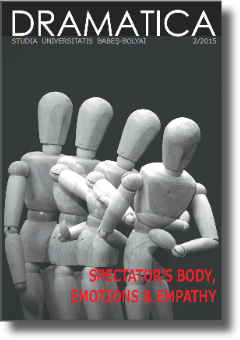STRATEGIES FOR THE EMBODIMENT AND DISEMBODIMENT OF SPECTATORSHIP: DON’T CRY BABY AND HOTEL BY EUGEN JEBELEANU
STRATEGIES FOR THE EMBODIMENT AND DISEMBODIMENT OF SPECTATORSHIP: DON’T CRY BABY AND HOTEL BY EUGEN JEBELEANU
Author(s): Miruna RuncanSubject(s): Theatre, Dance, Performing Arts
Published by: Studia Universitatis Babes-Bolyai
Keywords: Spectatorship; Theatre; Performing Arts; Body Perception; Audience Response; Neurosciences.
Summary/Abstract: This paper will emphasize a series of negotiation and renegotiation strategies for the corporeal-cognitive relationship between the actor and the spectator in contemporary experimental theatre. To this end, I have chosen two performances with totally different narrative and performative structures (a verbal one and a nonverbal one both staged by the same director, Eugen Jebeleanu and his team Compagnie 28: Don’t Cry Baby, a play by Catinca Drăgănescu, based on the typologies/situations in Charles Perrault’s Little Red Riding Hood, and Hotel, a free adaptation on F.X. Kroetz’s Wunschkonzert. The paper mixes the descriptive analysis of Jebeleanu’s performances with theoretical and applied perspectives from the fields of cognitive psychology and neurosciences, as well as of semiotics and pragmatics. The hypothesis I am trying to verify is that experimental shows performed in small spaces combine the corporeal-empathic and the cognitive challenges exerted on the spectator, sometimes turning the experience of the latter into a participatory game that involves an enhancement of one's proprioceptive internal sensations, a stronger perception of one's own body being alive and a participatory attendance.
Journal: Studia Universitatis Babes-Bolyai - Dramatica
- Issue Year: 2015
- Issue No: 2
- Page Range: 7-26
- Page Count: 20

